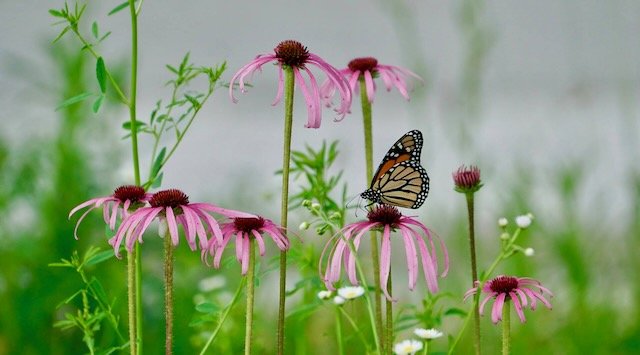While lizards may all look alike to you, they are entertaining and helpful to have around. They generally eat insects, spiders, and other invertebrates. Recently, we have been warned about the Italian Wall Lizard (Podarcis siculus), accidentally introduced into downtown Joplin some years ago. It has become well-established in town, and could compete with and endanger native lizards if it spreads into our rocky Wildcat and Silver Creek Glades.
Residents have been asked to report the location of Italian Wall Lizards inside the city to a research group at Texas A&M*, and to MDC if they see any on the glades. It has recently been placed on the Missouri “Prohibited List” which means you can’t hold them as a pet, even though they may be living in your yard. They also can’t be imported, exported, transported, sold, or purchased.
Prairie Racerunner
BUT here is where you need to become “lizard-aware.” There is a native lizard, the Prairie Racerunner (Cnemidophorus sexlineata viridis), that from a distance, looks similar to the Italian Wall Lizard. Both adult lizards are about 10” long as adults, but while the Prairie Racerunner has 6 or 7 definite, solid stripes, the Italian Wall Lizard has fewer stripes made up of a series of dashes or dots. Both lizards can have a greenish tinge.
Italian Wall Lizards
The Italian Wall Lizard is an urban species, originally from the Mediterranean area, comfortable on rock/brick/stucco walls and building foundations inside cities. They have been seen near City Hall! You may even see them sunning on a sidewalk in North Joplin. It is unlikely that they will ever disappear from Joplin. They have been here since 2000. Since the Italian Wall Lizard is territorial and known to be aggressive towards other lizards, we don’t want them on our glades
The Racerunner is found in open rocky areas, along gravel roads, railroad tracks, and commonly seen in our glades. They are a delight to hikers and part of our rich natural heritage. They are less likely to be seen inside Joplin City limits, but are welcome wherever they venture.
Do not confuse, or be afraid of either of these two lizards! Take a good look at these pictures, or the many you can see online if you look, and be sure you can recognize the difference.
*Take a picture and send it to: brichey@tamu.edu along with the address or GPS where you saw the lizard. If you see one (for sure) but did not photograph, still report with the location/address. Or if you have an iNaturalist account, enter it into the project called “Italian Wall Lizards in the United States”


